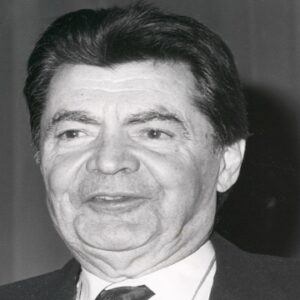George E. Palade was a Romanian-American cell biologist who shared the Nobel Prize in Physiology and Medicine with Albert Claude and Christian de Duve in 1974. Palade is known as “the most influential cell biologist of all time.” He was well-known for his contributions to electron microscopy and cell fractionation, which helped to pave the road for current molecular cell biology. He was raised in an intellectually stimulating environment in Romania, where he was born to a professor father and a teacher mother. He developed a deep appreciation for books, scholars, and education from a young age. George’s father wished for him to pursue philosophy, but he was more interested in science, particularly medicine. He graduated from the Carol Davila School of Medicine in Bucharest with an M.D. in 1940 and went on to pursue postdoctoral studies in the United States. At the Rockefeller Institute for Medical Research, he met Albert Claude and the two men worked together for a while. Palade investigated the internal organization of cell structures such as ribosomes, mitochondria, chloroplasts, and the Golgi apparatus using an electron microscope. His contribution to the creation of the technique known as cell fractionation, which played a crucial part in the development of contemporary molecular cell biology, garnered him a lot of attention.
Childhood and Adolescence
George Emil Palade was born in Iași, Romania, on November 19, 1912. Emil Palade, his father, was a philosophy professor, and Constanta Cantemir-Palade, his mother, was a teacher.
His parents fostered in him a strong love of reading and study as he grew up in an intellectually stimulating atmosphere.
His father wished for him to follow in his footsteps and study philosophy, but George was more interested in science. As a result, he enrolled in the University of Bucharest’s School of Medicine in 1930.
He had a significant interest in basic biological sciences while studying medicine, and Francisc Rainer and André Boivin, professors of Anatomy and Biochemistry, respectively, had a big influence on him.
While still in medical school, he began working in the Anatomy laboratory and completed six years of hospital training. He earned his M.D. in 1940 after completing his dissertation thesis in microscopic anatomy on the nephron of the cetacean Delphinus Delphi.
George E. Palade started his academic career as a professor at Carol Davila University, where he remained until 1946. Then he traveled to pursue postdoctoral research in the United States.
He joined Albert Claude’s studies at the Rockefeller Institute for Medical Research, which is now Rockefeller University. Palade first worked on cell fractionation processes, collaborating with Hogeboom and Schneider to create the “sucrose method” for homogenizing and fractionating liver tissue.
He has carried out important research on the internal organization of cell structures including mitochondria, chloroplasts, and the Golgi apparatus, among others. He was particularly interested in microsomes, and he was the first to discover what would later be known as ribosomes.
In 1952, he became a naturalized US citizen, and in 1958, he was named a professor of cytology at the Rockefeller Institute.
Palade studied the secretory process in the 1960s using two separate techniques, the first of which was based solely on cell fractionation. He worked on this strategy alongside Philip Siekevitz, Lewis Joel Greene, Colvin Redman, and others, which led to the discovery of secretory product segregation in the endoplasmic reticulum’s cisternal region.
He collaborated on the second technique with Lucien Caro and James Jamieson, which was based mostly on radioautography. Experiments on intact animals or pancreatic slices were used in the studies, which paved the path for more research into protein synthesis and intracellular processing.
In 1972, he left Rockefeller University to join Yale University Medical School, where he became the chief of the new cell biology department.
Palade became the first dean for scientific affairs at the University of California, San Diego (UCSD) School of Medicine in 1990. He was also a professor of medicine, where he built a world-class cell biology department. He left the company in 2001.
Major Works of George E. Palade
Palade was the first to use an electron microscope to view ribosomes. The ribosome is a cellular machine that is found in all cellular organisms and is responsible for protein synthesis.
He conducted a series of studies on membrane synthesis in eukaryotic cells alongside his colleagues, utilizing either the endoplasmic reticulum of human hepatocytes or the thylakoid membranes of a green alga as model objects. These findings add to our understanding of the endoplasmic reticulum (ER), a kind of organelle found in eukaryotic cells.
Achievements & Awards
He was awarded the Gairdner Foundation International Award in 1967.
George E. Palade, Albert Claude, and Keith R. Porter shared the Louisa Gross Horwitz Prize for Biology or Biochemistry in 1970.
“For their discoveries concerning the structural and functional structure of the cell,” George E. Palade, Albert Claude, and Christian de Duve shared the Nobel Prize in Physiology or Medicine in 1974.
Personal History and Legacy
Irina Malaxa was George E. Palade’s first wife, and they had two children. His wife died before he did.
In 1970, he married cell scientist Marilyn Gist Farquhar. From this marriage, he got two stepchildren.
On October 7, 2008, he passed away at the age of 95.
Estimated Net Worth
The estimated Net Worth of George E. Palade is unknown.


